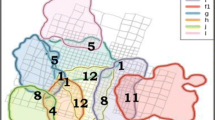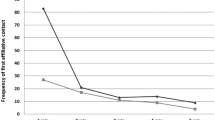Abstract
Animals derive benefits from living in social groups but sociality also has its costs in that animals must compete with others for resources and mating opportunities. To cope with the conflict aftermath and social damage caused by competitive aggression, several group-living species use a variety of peace-keeping strategies. The affinitive post-conflict reunion of former opponents, defined as reconciliation, is the primary peace-keeping mechanism. In this study, we provide evidence for the occurrence of reconciliation and test some hypotheses on this post-conflict mechanism in geladas (Theropithecus gelada), a species often neglected in the study of post-conflict dynamics. The conciliatory contacts were uniformly distributed across the different sex–class combinations. Different from baboons, geladas did not show any particular kind of affinitive reconciliation behaviour. Notwithstanding the presence of a linear hierarchy, the dominance relationships did not affect the reconciliation dynamics. According to the valuable relationship hypothesis, coalitionary support seems to be a good predictor for a high level of conciliatory contacts. Finally, at an immediate level reconciliation plays a role in reducing renewed attacks by aggressors, which sought conciliatory contact more frequently than victims. In conclusion, even though the study of post-conflict behaviour in geladas needs to be continued, the patchy nature of their social network is a good model for testing some of the theoretical assumptions about primate conflict resolution.



Similar content being viewed by others
References
Altmann J (1974) Observational study of behaviour sampling methods. Behaviour 49:227–265
Arnold K, Aureli F (2007) Postconflict reconciliation. In: Campbell CJ, Fuentes A, MacKinnon KC, Panger M, Bearder SK (eds) Primates in Perspective. Oxford University Press, Oxford, N.Y, pp 592–608
Aureli F, de Waal FBM (2000) (eds) Natural conflict resolution. University of California Press, Berkeley
Aureli F, van Schaik CP (1991) Post-conflict behaviour in long-tailed macaques (Macaca fascicularis): II Coping with the uncertainty. Ethology 89:101–114
Aureli F, van Schaik CP, van Hooff JARAM (1989) Functional aspects of reconciliation among captive long-tailed macaques (Macaca fascicularis). Am J Primatol 19:39–51
Aureli F, Das M, Veenema HC (1997) Differential kinship effect on reconciliation in three species of macaques (Macaca fascicularis, M. fuscata and M. sylvanus). J Comp Psychol 111:91–99
Aureli F, Cords M, van Schaik C (2002) Conflict resolution following aggression in gregarious animals: a predictive framework. Anim Behav 64:325–343
Bernstein I (1970) Primate status hierarchies. In: Rosenblum L (ed) Primate Behavior. Liss, New York, pp 71–109
Bertram BCR (1978) Living in groups: predators and prey. In: Krebs JR, Davies NB (eds) Behavioural ecology: an evolutionary approach. Blackwell Science, Oxford, pp 221–248
Boydston EE, Morelli TL, Holekamp KE (2001) Sex differences in territorial behavior exhibited by the spotted hyena (Hyaenidae, Crocuta crocuta). Ethology 107:369–385
Bramblett CA (1970) Coalitions among gelada baboons. Primates 11:327–333
Castles DL, Whiten A (1998) Post-conflict behaviour of wild olive baboons. I. Reconciliation, redirection and consolation. Ethology 104:126–147
Castles DL, Aureli F, de Waal FBM (1996) Variation in conciliation tendency and relationship quality across groups of pigiai macaques. Anim Behav 52:389–403
Colmenares F (2004) Kinship structure and its impact on behavior in multilevel societies. In: Chapais B, Berman C (eds) Kinship and Behavior in Nonhuman Primates. Oxford University Press, Oxford, pp 242–270
Cools AKA, van Hout AJM, Nelissen MHJ (2008) Canine reconciliation and third-party-initiated postconflict affiliation: do peacemaking social mechanisms in dogs rival those of higher primates? Ethology 3:113
Cooper MA, Bernstein IS, Hemelrijk CK (2005) Reconciliation and relationship quality in assamese macaques (Macaca assamensis). Am J Primatol 65:269–289
Cordoni G, Palagi E (2008) Reconciliation in wolves (Canis lupus): new evidence for a comparative perspective. Ethology 114:298–308
Cordoni G, Palagi E, Borgognini Tarli SM (2006) Reconciliation and consolation in captive western gorillas. Int J Primatol 27:1365–1382
Cords M (1992) Postconflict reunions and reconciliation in long-tailed macaques. Anim Behav 44:57–61
Cords M (1997) Friendship, alliances, reciprocity and repair. In: Whiten A, Byrne RW (eds) Machiavellian Intelligence II. Cambridge University Press, Cambridge, pp 24–49
Cords M, Aureli F (1993) Patterns of reconciliation among juvenile long-tailed macaques. In: Pereira ME, Fairbanks LA (eds) Juvenile Primates: Life History, Development, and Behavior. Oxford University Press, Oxford, pp 271–284
Cords M, Aureli F (2000) Reconciliation and relationship qualities. In: Aureli F, de Waal FBM (eds) Natural Conflict Resolution. University of California Press, Berkeley, pp 177–198
Cords M, Thurnheer S (1993) Reconciliation with valuable partners by long-tailed macaques. Ethology 93:315–325
de Vries H (1995) An improved test of linearity in dominance hierarchies containing unknown or tied relationships. Anim Behav 50:1375–1389
de Waal FBM (1986) The integration of dominance and social bonding in primates. Q Rev Biol 61:459–479
de Waal FBM, Aureli F (1996) Consolation, reconciliation, and a possible cognitive difference between macaques and chimpanzees. In: Russon AE, Bard KA, Parker ST (eds) Reaching into thought: the minds of the great apes. Cambridge University Press, Cambridge, pp 80–110
de Waal FBM, van Roosmalen A (1979) Reconciliation and consolation among chimpanzees. Behav Ecol Sociobiol 5:55–66
de Waal FBM, Yoshihara D (1983) Reconciliation and redirected affection in rhesus monkeys. Behaviour 85:224–241
Dunbar RIM (1979) Structure of gelada baboon reproductive units. I. Stability of social relationships. Behaviour 69:72–87
Dunbar RIM (1983a) Structure of gelada baboons reproductive units. III. The males’ relationship with his females. Anim Behav 31:565–575
Dunbar RIM (1983b) Structure of gelada baboons reproductive units. II. Social relationships between reproductive females. Anim Behav 31:556–564
Dunbar RIM (1984) Reproductive decision: an economic analysis of gelada baboon social strategies. Princeton University Press, Princeton, NJ
Dunbar RIM (1988) Primate social systems. Cornell University Press, Ithaca, N. Y
Dunbar RIM, Dunbar EP (1975) Social dynamics of gelada baboons. Karger, Basel
Giraldeau L, Beauchamp AG (1999) Food Exploitation: Searching for the optimal joining policy. Trends Ecol Evol 14:102–106
Holekamp KE, Cooper SM, Katona CI, Berry NA, Frank LG, Smale L (1997) Patterns of association among female spotted hyenas (Crocuta crocuta). J Mammal 78:55–64
Judge PG, Mullen SH (2005) Quadratic postconflict affiliation among bystanders in a hamadyras baboon group. Anim Behav 69:1345–1355
Kappeler PM, van Schaik CP (1992) Methodological and evolutionary aspects of reconciliation among primates. Ethology 92:51–69
Kawai M (1979) (ed) Ecological and sociobiological studies of gelada baboons. Contributions to Primatology. Karger, Basel
Kawai M, Dunbar RIM, Oshawa H, Mori U (1983) Social organization of gelada baboons: social units and definitions. Primates 24:13–24
Koski S, Sterck EHM (2007) Triadic postconflict affiliation in captive chimpanzees: does consolation console? Anim Behav 73:133–142
Koyama N, Palagi E (2006) Managing conflict: evidence from wild and captive primates. Int J Primatol 27:1235–1240
Krause J, Ruxton GD (2002) Living in groups. Oxford University Press, Oxford
Kummer H (1995) In quest of the sacred baboon: A Scientist’s Journey. Princeton University Press, Princeton
Mancini G, Palagi E (2009) Play and social dynamics in a captive herd of gelada baboons (Theropithecus gelada). Behav Proc 82:286–292
Martin P, Bateson P (1986) Measuring behavior-an introductory guide. Cambridge University Press, Cambridge
Maynard Smith J, Szmathmáry E (1995) The major transitions in evolution. Oxford University Press, Oxford
Mori U (1979a) Social structure of gelada baboons. In: Kawai M (ed) Ecological and sociological studies of gelada baboons. Karger, Basel, pp 243–247
Mori U (1979b) Individual relationships within a unit. In: Kawai M (ed) Ecological and sociological studies of gelada baboons. Karger, Basel, pp 94–122
Mori A, Belay G, Iwamoto T (2003) Changes in unit structures and infanticide observed in Arsi geladas. Primates 44:217–223
Mundry R, Fischer J (1998) Use of statistical programs for nonparametric tests of small samples often lead to incorrect P values: examples from animal behavior. Anim Behav 56:256–259
Noë R, Hammerstein P (1994) Biological markets: supply and demand determine the effect of partner choice in cooperation, mutualism and mating. Behav Ecol Sociobiol 35:1–11
Norscia I, Antonacci D, Palagi E (2009) Mating first, mating more: biological market fluctuation in a wild prosimian. PLoS ONE 4(3):e4679. doi:10.1371/journal.pone.0004679
Palagi E, Cordoni G (2009) Triadic post-conflict affiliation in Canis lupus: do wolves share similarities with the great apes? Anim Behav 78:979–986
Palagi E, Paoli T, Borgonini Tarli SM (2004) Reconciliation and consolation in captive bonobos (Pan paniscus). Am J Primatol 62:15–30
Palagi E, Cordoni G, Borgonini Tarli SM (2006) Possible roles of consolation in captive chimpanzees (Pan troglodytes). Am J Phys Anthropol 129:105–111
Palagi E, Chiarugi E, Cordoni G (2008a) Peaceful post-conflict interactions between aggressors and bystanders in captive lowland gorillas (Gorilla gorilla gorilla). Am J Primatol 70:949–955
Palagi E, Antonacci D, Norscia I (2008b) Peacemaking on treetops: first evidence of reconciliation from a wild prosimian (Propithecus verreauxi). Anim Behav 76:737–747
Palagi E, Leone A, Mancini G, Ferrari PF (2009) Contagious yawning in gelada baboons as a possible expression of empathy. Proc Nat Acad Sci 106:19262–19267
Preuschoft S, Wang X, Aureli F, de Waal FBM (2002) Reconciliation in captive chimpanzees: a re-evaluation with controlled methods. Int J Primatol 23:29–50
Romero T, Colmenares F, Aureli F (2008) Postconflict affiliation of aggressors in Papio hamadryas. Int J Primatol 29:1591–1606
Schino G (1998) Reconciliation in domestic goats. Behaviour 135:343–356
Schino G, Polizzi di Sorrentino E, Tiddi B (2007) Grooming and coalitions in Japanese macaques (Macaca fuscata): partner choice and the time frame of reciprocation. J Comp Psychol 121:181–188
Siegel S, Castellan NJJ (1988) Non parametric statistics for the behavioral sciences. McGraw Hill, New York
Silk JB (2007a) The adaptive value of sociality in mammalian groups. Phil Trans 362:539–559
Silk JB (2007b) Animal behavior: conflict management is for the birds. Curr Biol 17:R50–R51
Silk JB, Cheney DL, Seyfarth RM (1996) The form and function of post-conflict interactions between female baboons. Anim Behav 52:259–268
Smuts BB (1987) Gender, aggression, and influence. In: Smuts BB, Cheney DL, Seyfarth RM, Wragham RW, Struhsaker TT (eds) Primate societies. University of Chicago Press, Chicago, pp 400–412
Spivak H (1971) Ausdrucksformen und soziale beziehungen in einer dschelada-gruppe (Theropithecus gelada). Zoo Z Tierpsychol 28:279–296
Swedell L (1997) Patterns of reconciliation among captive gelada baboons (Theropithecus gelada). Primates 38:325–330
Thierry B, Aureli F, Nunn CL, Petit O, Abegg C, de Waal FBM (2008) A comparative study of conflict resolution in macaques: insights into the nature of trait covaration. Anim Behav 75:847–860
van Hooff JARAM (2001) Conflict, reconciliation and negotiation in non-human primates: the value of long-term relationships. In: Noe R, Van Hooff JARAM, Hammerstein P (eds) Economics in Nature-Social Dilemmas, Mate Choice and Biological Markets. Cambridge University Press, Cambridge, pp 67–89
van Hooff JARAM, Wensing JAB (1987) Dominance and its behavioral measures in a captive wolf pack. In: Frank I (ed) Men and Wolf: Advances, Issues, and Problems in Captive Wolf Research. Junk Publishers, Boston, pp 219–252
van Schaik CP, Aureli F (2000) The natural history of valuable relationships in primates. In: Aureli F, de Waal FBM (eds) Natural Conflict Resolution. University of California Press, Berkeley, pp 307–333
Veenema H, Das M, Aureli F (1994) Methodological improvements for the study of reconciliation. Behav Process 31:29–38
Vehrencamp S (1983) A model for the evolution of despotic versus egalitarian societies. Anim Behav 31:667–682
Wahaj SA, Guse KR, Holekamp KE (2001) Reconciliation in spotted hyenas (Crocuta crocuta). Ethology 107:1057–1074
Watts DP (1995) Post-conflict social events in wild mountain gorillas (Mammalia, Hominoidea). I. Social interactions between opponents. Ethology 100:139–157
Watts DP, Colmenares F, Arnold K (2000) Redirection, consolation, and male policing: how targets of aggression interact with bystanders. In: Aureli F, de Waal FBM (eds) Natural conflict resolution. University of California Press, California, pp 281–301
Weaver A (2003) Conflict and reconciliation in captive bottlenose dolphins, Tursiops truncatus. Mar Mamm Sci 19:836–846
Acknowledgments
Thanks are due to the RheineZoo, Rheine (Germany): the director, Achim Joahnn, and the gelada keepers for allowing and facilitating this work; Giada Mancini and Michele Mignini for collaboration with data collection; Ivan Norscia for his invaluable comments on the manuscript; Cecilia Ragaini for language revision; and Grignolino for his important clarifying input in discussing results. This research was supported by private funding and it complies with current laws of Italy and Germany.
Author information
Authors and Affiliations
Corresponding author
About this article
Cite this article
Leone, A., Palagi, E. Reconciling conflicts in a one-male society: the case of geladas (Theropithecus gelada). Primates 51, 203–212 (2010). https://doi.org/10.1007/s10329-010-0188-4
Received:
Accepted:
Published:
Issue Date:
DOI: https://doi.org/10.1007/s10329-010-0188-4




